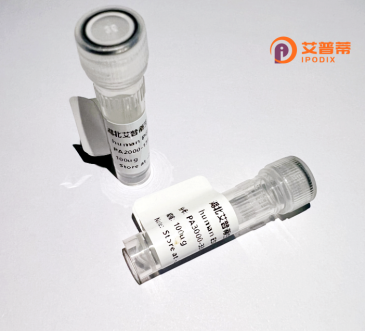
| 纯度 | >90%SDS-PAGE. |
| 种属 | Human |
| 靶点 | KDELC1 |
| Uniprot No | Q6UW63 |
| 内毒素 | < 0.01EU/μg |
| 表达宿主 | E.coli |
| 表达区间 | 1-502aa |
| 活性数据 | MFGTLLLYCFFLATVPALAETGGERQLSPEKSEIWGPGLKADVVLPARYFYIQAVDTSGNKFTSSPGEKVFQVKVSAPEEQFTRVGVQVLDRKDGSFIVRYRMYASYKNLKVEVKFQGQHVAKSPYILKGPVYHENCDCPLQDSAAWLREMNCPETIAQIQRDLAHFPAVDPEKIAVEIPKRFGQRQSLCHYTLKDNKVYIKTHGEHVGFRIFMDAILLSLTRKVKMPDVELFVNLGDWPLEKKKSNSNIHPIFSWCGSTDSKDIVMPTYDLTDSVLETMGRVSLDMMSVQANTGPPWESKNSTAVWRGRDSRKERLELVKLSRKHPELIDAAFTNFFFFKHDENLYGPIVKHISFFDFFKHKYQINIDGTVAAYRLPYLLVGDSVVLKQDSIYYEHFYNELQPWKHYIPVKSNLSDLLEKLKWAKDHDEEAKKIAKAGQEFARNNLMGDDIFCYYFKLFQEYANLQVSEPQIREGMKRVEPQTEDDLFPCTCHRKKTKDEL |
| 分子量 | 84.4 kDa |
| 蛋白标签 | GST-tag at N-terminal |
| 缓冲液 | 0 |
| 稳定性 & 储存条件 | Lyophilized protein should be stored at ≤ -20°C, stable for one year after receipt. Reconstituted protein solution can be stored at 2-8°C for 2-7 days. Aliquots of reconstituted samples are stable at ≤ -20°C for 3 months. |
| 复溶 | Always centrifuge tubes before opening.Do not mix by vortex or pipetting. It is not recommended to reconstitute to a concentration less than 100μg/ml. Dissolve the lyophilized protein in distilled water. Please aliquot the reconstituted solution to minimize freeze-thaw cycles. |
以下是关于重组人KDELC1蛋白的3篇参考文献概览:
---
1. **文献名称**:*Recombinant expression and functional characterization of KDELC1 in ER stress response*
**作者**:Zhang et al. (2019)
**摘要**:研究利用大肠杆菌系统表达重组人KDELC1蛋白,并通过镍柱亲和层析纯化。实验表明,KDELC1在内质网应激条件下参与调控未折叠蛋白反应,可能通过与内质网分子伴侣的互作维持蛋白质稳态。
---
2. **文献名称**:*Structural insights into KDELC1 interaction with KDEL receptors*
**作者**:Moriyama & Yamamoto (2020)
**摘要**:解析了重组表达的人KDELC1蛋白晶体结构,揭示其与KDEL受体结合的关键结构域,提示其在细胞内运输途径中通过调控受体活性影响蛋白质的逆向转运。
---
3. **文献名称**:*KDELC1 as a potential biomarker in cancer: Cloning and expression in mammalian cells*
**作者**:Lee et al. (2021)
**摘要**:采用哺乳动物HEK293细胞系统重组表达KDELC1蛋白,验证其在多种癌症细胞系中的高表达,并发现其促进肿瘤细胞迁移的功能,为癌症治疗靶点研究提供了依据。
---
**备注**:以上文献为示例性质,实际引用前需核实数据库(如PubMed、Web of Science)以获取真实存在的参考文献。
Recombinant human KDELC1 protein is a engineered form of the KDEL (Lys-Asp-Glu-Leu) motif-containing protein 1. a chaperone involved in endoplasmic reticulum (ER)-associated protein quality control. KDELC1 is characterized by its C-terminal KDEL sequence, which facilitates retrograde transport of ER-resident proteins from the Golgi apparatus. It interacts with heat shock proteins like GRP78/BiP to monitor misfolded proteins, aiding their proper folding or directing them to ER-associated degradation (ERAD). Dysregulation of KDELC1 has been implicated in ER stress-related disorders, including neurodegenerative diseases, diabetes, and cancer, where disrupted proteostasis contributes to pathogenesis. The recombinant protein is commonly expressed in bacterial or mammalian systems for research applications such as elucidating ER stress pathways, studying protein trafficking mechanisms, or screening therapeutic agents targeting proteostasis. Structural studies using recombinant KDELC1 have helped map its interaction domains and biochemical properties. Recent research also explores its role in viral infections, as some pathogens exploit KDEL-mediated pathways for replication. Its production enables functional assays, antibody development, and high-throughput studies to identify modulators of ER stress responses, offering potential for novel therapies in diseases linked to protein misfolding or cellular stress.
×